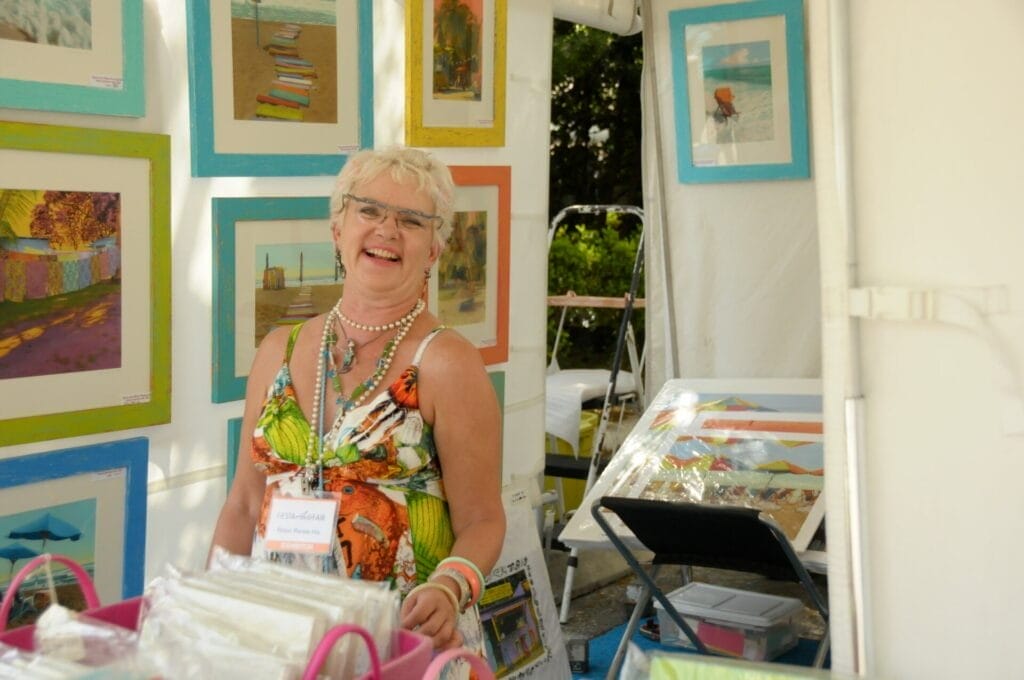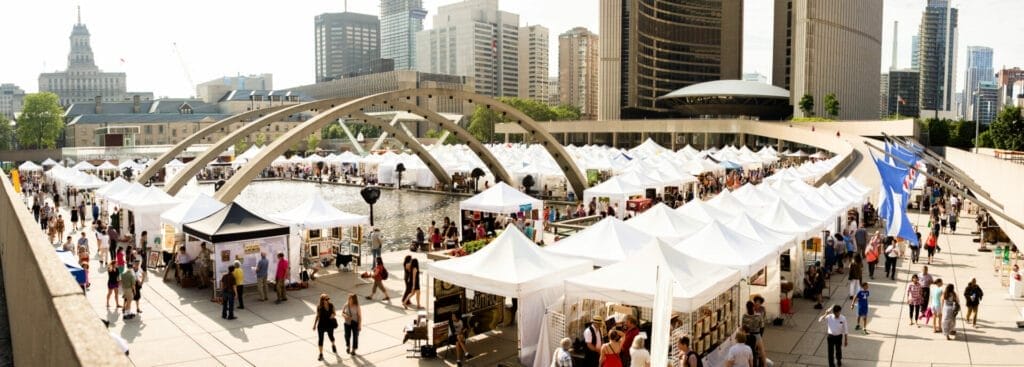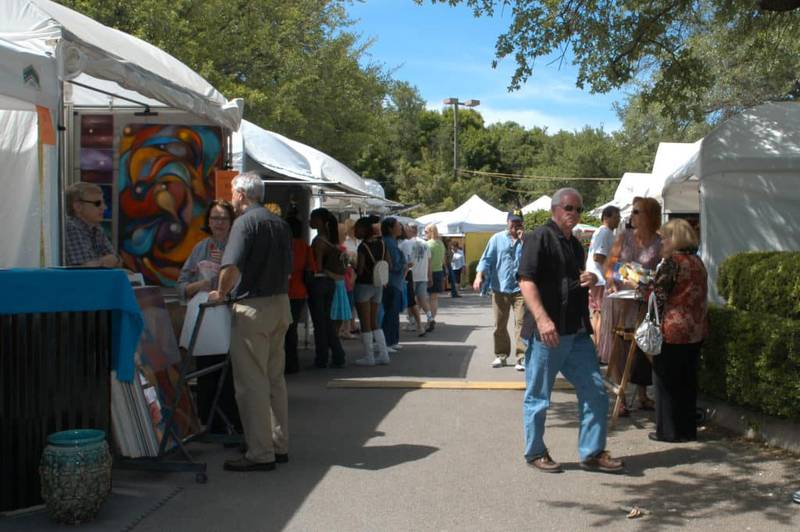
Welcome to the practical guide for artists looking to participate in art fairs and festivals! As an artist, showcasing your work at these events can be an exciting and rewarding experience, offering opportunities for increased exposure, networking, and sales.
However, navigating the world of art fairs can also be challenging, with various factors to consider, such as booth design, marketing strategies, and legal and financial obligations.
In this comprehensive guide, we’ll walk you through every aspect of participating in an art fair, from deciding whether it’s worth it and choosing the right venue, to effectively displaying and selling your artwork.
Your Art Vendor Booth Success Guide
Throughout this guide, you’ll learn how to set clear goals for your art fair participation, understand the unique characteristics of different types of venues, and create a cohesive and compelling brand identity.

We’ll also delve into the logistics of preparing for an art fair, including pricing your work, packing and transportation, and booth setup. Additionally, we’ll explore strategies for managing your booth, attracting potential customers, and closing sales, as well as post-event follow-up and evaluation.
Whether you’re a seasoned art fair veteran or a newcomer to the scene, this guide is designed to equip you with the knowledge and tools you need to make your art fair experience a successful and enjoyable one. So, let’s dive in and explore the vibrant world of art fairs and festivals together!
Is it Worth it? – Art Vendor Booth Expectations
Before jumping headfirst into the vibrant world of art fairs and festivals, it’s crucial to ponder on one important question: Is it worth it? Navigating through the energetic buzz of a fair, setting up an enticing booth, and trying to sell your artwork amidst a sea of other artists can be an exhilarating yet daunting experience. So, let’s break it down and weigh the pros and cons.

Making the Call: Evaluating Festival Opportunities
Art fairs are a great platform for artists to connect directly with their audience, gain exposure, and of course, sell art. But participation comes with its own set of challenges – costs, competition, time investment, and sometimes, unpredictable foot traffic. So, it’s crucial to evaluate whether the potential returns justify the effort.
Goals for Participating in Art Fairs
Each artist has unique motivations for participating in art fairs. For some, the main objective is to increase sales, while others may value the exposure and networking opportunities that these fairs provide.
As an artist, setting clear, tangible goals will help guide your participation and provide a metric for success. Your goals could be quantifiable, like selling a specific number of pieces or making a certain amount of revenue, or qualitative, like gaining feedback, connecting with potential collectors, or growing your mailing list.
Tangible and Intangible Benefits of Having a Booth
Having a vendor booth at an art fair comes with both tangible and intangible benefits. Tangibly, you’re looking at potential sales and profits. Selling your art at a fair gives you the chance to reach a broader audience that you may not have had access to otherwise, potentially leading to increased sales.
On the intangible side, fairs provide valuable exposure for your art business. They allow you to meet your audience in person, understand their tastes and preferences, and build relationships. Being a part of an art fair can also lead to networking opportunities with other artists and industry professionals, contributing to your growth as an artist.
Discussing Potential Challenges: Costs, Time Investment, Competition, etc.
The potential challenges associated with participating in an art fair shouldn’t be overlooked. Costs are a major factor. These may include the booth rental, transportation of artwork, display setup, insurance, and any promotional materials.
Additionally, preparing for a fair is time-consuming and requires a lot of planning and effort. The art fair scene can also be quite competitive, with many artists vying for the attention of potential buyers.
Setting Realistic Expectations and Return on Investment

So, is it worth it? Well, that largely depends on your personal goals, preparedness, and adaptability. When you contemplate your return on investment, consider all the factors involved – both monetary and non-monetary.
Make sure to set realistic expectations and understand that success might not come immediately but could build over time as you gain more experience and recognition.
Deciding to participate in an art fair is a major step for any artist. It requires careful thought, planning, and a touch of creativity. While challenges exist, the potential benefits make art fairs a significant avenue for artists to explore. With the right preparation and mindset, you could make your art fair experience a rewarding journey.
Choosing the Right Opportunity and Venue for Your Art
Just as every piece of art is unique, so are the venues where they are showcased. Your choice of venue plays a crucial role in the visibility of your work, potential sales, and overall success at an art fair. Therefore, understanding the characteristics of different venues and selecting one that fits your style and goals is paramount.
Understanding the Unique Characteristics of Each Type of Venue
There are various types of venues where artists can sell their work: Art Fairs, Weekend Markets, Street Markets, and Art Shows, to name a few.
- Art Fairs are typically large, well-organized events featuring a range of art from various artists. These fairs can draw substantial foot traffic and are often frequented by art collectors. They can offer significant sales potential, but may also be highly competitive and carry higher booth costs.
- Weekend Markets and Street Markets, on the other hand, are typically more casual and eclectic, offering a mix of crafts, food, and art. While the audience might not be exclusively focused on art, these venues can provide broad exposure and are often less expensive to join.
- Art Shows often have a more focused audience, usually centered around a specific type or style of art. These shows can be a great opportunity to connect with a target audience interested in your specific niche of work.
Each venue type presents its own unique benefits and challenges. Therefore, it’s essential to adjust your approach to fit the characteristics and requirements of your chosen venue.
Researching and Selecting Appropriate Events
Before you apply to participate in an event, do your homework. Research factors like the size of the event, the typical audience, the location, and the experiences of previous artists.
The size of the event can influence the number of potential buyers. Large events can attract more foot traffic, but may also come with more competition. Smaller events might offer more opportunities for one-on-one interaction with attendees.
Understanding the target audience is key. You need to know whether the attendees of the event would be interested in your type of art. Some events attract high-end art collectors while others cater to a more casual, eclectic crowd.
The location of the event can also impact your success. Is it in a high-traffic urban area or a more remote, rural spot? You’ll also want to consider the logistical aspects of getting your artwork to the event.
Finally, learning from previous artists’ experiences can be invaluable for a successful art show. Seek out reviews or feedback from artists who’ve participated in the past to gain insights into the event’s organization, audience, and sales potential.
Application Process: Tips and Tricks for Getting Accepted
Most art fairs require an application to secure a vendor booth. When applying, make sure to present your work professionally. High-quality photos of your artwork and a well-crafted artist statement can help you stand out. If a portfolio or website is requested, ensure it’s up-to-date and visually appealing. It’s also beneficial to tailor your application to the event, demonstrating why your work is a good fit for their audience.
Considerations When Choosing a Booth Location
Once accepted, you may have the opportunity to select your booth space and location. A spot near the entrance or along a main walkway can attract more attendees. However, these locations can also be more expensive or in high demand. Consider factors like visibility, foot traffic, proximity to other artists with similar work, and exposure to the elements when choosing your booth spot.
In conclusion, selecting the right venue for your art is a multi-step process involving thorough research, understanding your art business, and making informed decisions. Doing so can increase your chances of a successful art fair experience and pave the way for your artwork to shine.
Putting Your Artist Brand First

Establishing a cohesive and compelling brand identity is a crucial component of a successful art business. Your brand isn’t just a logo or a name; it’s a combination of your unique style, vision, and the experience you offer to your customers. At an art fair, your brand becomes a visual language that communicates your story to potential buyers.
Understanding the Importance of a Cohesive Brand Identity
A cohesive artist brand identity can set you apart from other vendors at the fair and help create a memorable impression on attendees. It includes consistent use of colors, fonts, and themes in your booth design, art display, signage, and promotional materials. Your brand should encapsulate your artistic style and persona, giving fairgoers a clear sense of who you are as an artist and what your work represents.
Tips for Branding Your Booth
Start by considering your brand’s color palette and integrating it into your booth design. Consistent use of colors across your booth can draw the eye and reinforce your brand identity. Similarly, fonts should align with your brand’s style. If your brand is modern and minimalistic, a clean, sans-serif font might be a good fit. If your brand is more traditional or whimsical, consider a serif or script font.
Your brand’s themes should also play a significant role in your booth design. For instance, if nature is a recurring motif in your artwork, consider incorporating natural elements into your booth setup.
How Your Brand Influences Booth Design, Art Display, and Customer Interaction
Your brand should guide your booth layout and how you display your artwork. For example, if your brand is sleek and contemporary, a minimalistic display with plenty of white space might be most effective. On the other hand, a vintage-inspired brand might benefit from a more maximalist, eclectic display.
Finally, your brand extends to how you interact with customers. Are you approachable and friendly, or more reserved and professional? Your brand’s personality should inform your customer interactions, helping you connect with potential buyers in a genuine way.
Remember, your brand is a reflection of you and your art. Let it shine at the art fair, and you’ll not only attract more foot traffic but also leave a lasting impression on attendees.
Preparing for an Art Fair: Strategies and Logistics

A successful art fair experience requires thoughtful preparation. From correctly pricing your artwork to packing for transportation and planning your booth layout, each aspect contributes to your overall success.
Art Pricing: Tips on Pricing Your Work Correctly
Determining the right price point for your artwork can be one of the most challenging aspects of selling art. Here are a few tips to help you price your work correctly:
- Consider your costs: Factor in the cost of materials, time spent creating, booth fees, and transportation costs.
- Research the market: Look at the prices of comparable artwork by artists with a similar level of experience and recognition.
- Price consistency: Keep your pricing consistent. It can confuse potential buyers if similar pieces have drastically different prices.
- Perceived value: Pricing your work too low can actually discourage sales if buyers perceive it as low quality. Don’t undervalue your art.
Read or in-depth guide here on Pricing Your Art
Preparing Your Art for Display and Transportation
Ensuring your artwork arrives at the fair in perfect condition requires careful packing and transportation. When packing, protect surfaces with acid-free tissue paper or glassine. Use bubble wrap for additional protection, especially for framed pieces, and secure everything in sturdy containers or boxes.
Planning your booth layout ahead of time can also streamline setup. Create a sketch or digital layout, considering how each piece will be displayed for the best visibility and accessibility. This will also help you understand what display aids (like easels, pedestals, or wall mounts) you’ll need to bring.
Creating Compelling Signage
Signage plays a crucial role in attracting attendees to your booth and helping them understand your work. Your signs should be clear, professional, and consistent with your brand identity. Make sure you have a prominent sign with your name or logo, price tags for each piece of artwork, and perhaps a few informational signs about your work or process. Place signs at eye level where they’re easily readable.
Weather Considerations

If the art fair is outdoors, you’ll need to plan for weather variability. Canopies or umbrellas can provide protection from sun and light rain. Make sure your artwork is displayed so it won’t be damaged by wind or unexpected weather changes. Weight your booth adequately to prevent it from tipping or blowing over in windy conditions.
Inventory Management
Deciding how much original artwork to bring can be tricky. Too little might limit your sales opportunities, while too much could make your booth feel cluttered. Consider the duration of the event, the expected attendance, and the size of your booth. It’s also beneficial to bring a range of pieces, from more affordable prints to higher-priced original pieces, to appeal to a broader demographic.
Essential Equipment
Don’t forget about the equipment you’ll need for booth setup and event management. This might include tables, chairs, display aids, lighting, a canopy for outdoor events, extension cords, and a dolly or cart for moving your artwork. Also consider sales and business materials like a credit card reader, receipt book, business cards, and packaging materials for sold art.
Preparing Yourself: What to Wear
Lastly, consider your own attire. Dress professionally and comfortably, as you’ll be on your feet most of the day. Your outfit should align with your brand identity, be appropriate for the weather, and include comfortable shoes.
By carefully planning these logistics, you’ll be well-prepared to make your art fair a successful event.
Digital Integration in Your Art Booth

In today’s technologically advanced world, integrating digital elements into your art booth can significantly enhance your art fair attendees’ experience and potentially increase your sales and exposure. From QR codes to digital portfolios and social media, let’s explore some practical ways to bring technology into your booth.
Using QR Codes for Contactless Information Sharing
QR codes provide a fast and contactless way for customers to access information about your art. These codes can be printed on your business cards, art tags, or promotional materials. When scanned using a smartphone, the code can redirect to your website, an online portfolio, a product page, or even your social media profiles. QR codes are a fantastic way to bridge the gap between the physical and digital worlds, making it easier for potential buyers to connect with your art business.
Creating a Digital Catalog or Portfolio for Customers to Browse
A digital catalog or portfolio allows potential customers to browse your entire collection, not just the pieces present at the fair. This can be particularly useful if you have a large body of work or offer customizable pieces. A digital portfolio provides a broader look at your abilities as an artist and might encourage customers to commission a work or purchase a piece they fell in love with at the fair.
Encouraging Social Media Engagement
Social media can play a crucial role in promoting your art and expanding your reach. Here are a few ways to encourage social media engagement at your booth:
- Interactive elements: Create a corner of your booth for a photo opportunity. It could be as simple as a backdrop featuring your art or something more interactive that relates to your work. Encourage visitors to take a picture and share it on their social media, tagging your artist profile.
- Hashtags: Develop a unique hashtag related to your art business and display it prominently in your booth. Encourage attendees to use this hashtag when they post about your work.
- Live social media updates: Throughout the fair, post updates, share photos, or even live-stream from your booth to engage your online followers.
Integrating digital elements into your art vendor booth not only provides a modern and engaging experience for your visitors but also opens up new avenues for expanding your brand’s reach and driving more sales.
Creating an Attractive Booth Display
First impressions are everything, especially when it comes to attracting potential buyers at an art fair or craft fair. The design and atmosphere of your booth play a critical role in drawing people in and creating a space where they feel comfortable and engaged.
Also, read our post on 7 Essential Tips on How to Sell Your Art Locally and Thrive
Significance of Booth Design in Attracting Potential Customers
Booth design can be the difference between an attendee walking past or stepping in to explore your work. An attractive booth tells a story about you and your art, enticing people to learn more. Keep in mind that people can’t appreciate your art if they don’t notice your booth in the first place.
Essential Elements of a Captivating Booth Design
Creating an appealing booth involves several key elements. First and foremost, your booth should be clean, organized, and well-lit, highlighting the artwork you’re looking to sell. Incorporate a theme that represents your style and brand, ensuring everything from the display stands to the banners contributes to a cohesive presentation.
The Impact of Color
Color can have a significant effect on people’s emotions and behaviors. Choosing the right hues for your booth, tablecloths, and backdrops can help create an inviting atmosphere. Coordinate colors that complement your art without overpowering it. If you’ve already established brand colors, incorporate them into your booth for brand consistency.
Importance of Lighting
Good lighting can make or break your booth. It draws attention to your artwork and creates a warm, welcoming ambiance. Make sure every piece is well-lit so potential buyers can appreciate the detail and craftsmanship. Portable spotlights can be a great addition if the craft fair is indoors or during the evening hours.
Creating an Atmosphere
Creating an atmosphere is all about making your booth a place where attendees want to linger. It should invite exploration and engagement. Play soft background music if it’s allowed. If you’re interested in doing commissions, display examples of previous commissioned work.
Do’s and Don’ts of Booth Design
Do’s
- Do make your booth inviting and open. Don’t block the entrance.
- Do create a diverse display with different heights and depths.
- Do have your business name and logo prominently displayed.
Don’ts
- Don’t clutter your space. Too much artwork can be overwhelming.
- Don’t leave price tags hidden. Customers wouldn’t want to ask for every piece’s price.
- Don’t forget to consider the viewer’s perspective.
Practical Tips for Booth Setup and Break Down
Planning ahead will make the process of setting up and breaking down your booth much more manageable. Consider using modular, lightweight displays for easy transportation. Assemble and disassemble your booth at home a few times before the event to ensure you’re well-prepared. And remember, it’s okay to ask for help if you need it.
Creating an attractive booth is an art in itself. It’s an extension of your brand and an invitation to attendees to step into your world. So, be creative, have fun with it, and you’ll likely find success in local art shows.
Managing Your Booth
The art of managing your booth at art festivals involves more than just setting up and showcasing your work. It includes staffing decisions, handling different traffic periods, and strategically taking breaks to maintain momentum and potential sales. Here’s a closer look at each.
Booth Staffing: Should You Hire Help or Manage It Yourself?
Deciding whether to hire help or manage the booth yourself depends on a few key factors, such as the size of the event, the complexity of your setup, and your budget. If you are new to art festivals or have a smaller setup, you might be able to manage on your own. This self-management approach also allows direct interaction with every potential collector that comes by, which could lead to increased sales.
However, if you anticipate high foot traffic or have a complex booth setup, hiring an assistant could prove beneficial. They can handle transactions, provide breaks, and help with customer inquiries, giving you more time to engage with customers deeply and discuss your work. An assistant could be a friend, family member, or a hired professional. Remember, the assistant should cover the basics of your type of art, its price points, and the story behind your work.
Dealing with Periods of High Traffic Versus Low Traffic
High-traffic periods, while potentially overwhelming, are great opportunities for increasing sales and engaging with a broad audience. During these periods, be proactive in engaging with visitors, and don’t forget to hand out business cards for potential follow-up contact. An assistant can be particularly beneficial in these times, ensuring that all visitors receive attention.
During low-traffic periods, utilize this time to reorganize your booth, rest, or network with other vendors. It’s also an excellent time for more extended, in-depth discussions with interested visitors.
Managing Breaks Without Losing Potential Sales
Taking regular breaks is essential for maintaining your energy throughout the day. However, it’s important to manage them strategically to avoid missing out on potential sales. Here are a few strategies:
- Schedule your breaks during traditionally slower times, typically mid-afternoon.
- If you have an assistant, stagger your breaks so someone is always present at the booth.
- Keep breaks brief and try to stay nearby just in case a serious buyer shows up.
Remember, art vendor booth management is a dynamic process. It’s crucial to stay adaptable and attuned to the flow of the event and the needs of the attendees. Your ability to efficiently manage your booth will contribute significantly to your art festival experience and success.
Displaying Your Art
Effective display of your artwork is pivotal to your success at an art fair. The right positioning and protection strategies can enhance visibility, increase accessibility, and protect your work from potential damage.
Correctly Positioning Your Artwork: Importance of Visibility and Accessibility
Positioning is key when it comes to making your artwork noticeable. Strategically place your most striking and attention-grabbing pieces at eye level and in the most visible locations, such as the center or the front of your booth. This helps to draw attention to your booth from a distance and entices potential customers to come in for a closer look.
Consider the flow of foot traffic and position your artwork in a way that is easily accessible and viewable from different angles. Be mindful of overcrowding your booth, as too many pieces in a small space can be a turnoff for some attendees. Instead, aim for a balance that showcases a variety of your work without making the space feel cluttered or overwhelming.
Protecting Your Artwork: Considerations for Weather and Security
The protection of your artwork is paramount. If the art fair is outdoors, prepare for weather changes. Use protective coverings and materials that are water and UV resistant to shield your work from rain or harsh sunlight.
For security, consider using sturdy display panels or racks that keep your artwork secure. Also, never leave your booth unattended, and at the end of the day, ensure that your artwork is safely stored away.
Remember, effective display and protection of your art not only showcase it in the best light but also ensures its longevity and maintain its quality throughout the event.
For more information, read our post on 4 Tips on How to Hang Artwork at an Art Festival
Marketing Your Art Event
Marketing your art effectively can significantly enhance your success at an art fair. It involves a combination of pre-event marketing, attracting fairgoers to your booth, using storytelling, understanding your customers, and leveraging social media.
Pre-event Marketing: Social Media, Email Newsletters, and More
Start marketing your participation in the art fair weeks prior to the event. Use your social media platforms to post teasers of your artwork, information about the event, and your booth number. This not only informs your existing followers about your participation but also creates anticipation.
Additionally, consider sending out email newsletters or postcards to your mailing list, giving them a heads up about the upcoming event and inviting them to visit your booth.
Attracting Fairgoers to Your Booth
Your booth should be aesthetically pleasing and reflect your artistic style to attract your target demographic. Make sure to have engaging elements that draw attention, like a unique piece of art, live demonstrations, or an interesting booth setup.
Using Storytelling to Sell Your Art
Every piece of art has a story. Share these stories with visitors as it can make the artwork more relatable and memorable. It can also evoke emotions, adding an extra layer of connection between the potential customer and your art.
How to Deal with Different Types of Customers
Recognize that every visitor to your booth is unique. Some might just want to browse, others may have specific questions, while some might be ready to buy. Adapt your approach to fit the customer’s needs, being patient with browsers, informative with inquirers, and direct with buyers.
In-Person Sales and Transactions
Executing sales and managing transactions effectively is a critical aspect of your art fair experience. With the right transaction method and sales tactics, you can ensure a smooth and profitable event.
Choosing a Transaction Method: Cash, Card, Digital Payments

Before you get to the fair, plan ahead about how you will handle transactions. Cash is a common method, but it’s also important to have alternatives.
Many customers prefer paying by card, so having a credit card reader on hand can greatly increase your sales. Digital payment solutions, such as PayPal or Venmo, are also becoming increasingly popular due to their convenience and contactless nature.
Make sure to clearly display the payment methods you accept. You might want to consider a sticker or sign that indicates you accept cards and digital payments. This can reassure potential buyers and eliminate any payment-related hesitations.
Engaging Customers, Handling Objections, Closing Sales
Engaging with customers is crucial for successful sales. Be friendly and approachable, but also give customers space to view your work without pressure. If a customer seems interested in a piece, offer more information about it or share the story behind the creation.
Handling objections is another vital part of sales. Listen to customers’ concerns and address them effectively. For example, if a customer is hesitant due to the price, discuss the time, effort, and materials that went into creating the piece.
Closing a sale often involves a gentle push. When a customer appears ready to buy, assist them in completing the purchase swiftly and smoothly.
Tips for Up-selling and Cross-Selling
Up-selling and cross-selling can increase your sales considerably. If a customer is interested in a particular piece, you might suggest a more elaborate or larger piece (up-selling), or recommend an additional smaller piece that complements their choice (cross-selling).
Finally, don’t forget to offer a business card with every sale. It’s an opportunity for future engagement, reminding customers of their visit and encouraging them to explore more of your work online after the fair.
By being prepared for sales and transactions at the art fair, you can maximize your earning potential and provide a better shopping experience for your customers.
Post-Event Strategies
The end of an art fair does not mark the end of your work. Post-event strategies are crucial to retain your customers, evaluate your success, and prepare for future events.
Follow-up Marketing: Retaining Your Customers Post-Sale
After the fair, take a break to relax, but don’t forget to follow up with your new customers. A thank-you email can make your customers feel valued and keep you at the forefront of their minds. This is where a mailing list comes in handy. If you collected email addresses at the fair, send a personalized note thanking each customer for their purchase. You can also provide information about your upcoming events or new pieces of art.
Evaluating Your Success: Metrics and Measures
To evaluate the success of your fair, consider various metrics. Calculate your profits by subtracting your total costs from total sales. Show costs include booth rental, transportation, materials, and time invested. But don’t forget to evaluate less tangible measures of success, such as the number of new potential collectors, contacts made, or email addresses collected.
Learning from the Event: Identifying Areas for Improvement
Every art fair offers a learning experience. Reflect on what went well and what areas require improvement. Perhaps you need a better booth setup, or maybe your prices weren’t quite right. Look at every piece of feedback and consider how you can improve when it comes to presentation, sales tactics, or customer interaction.
Legal and Financial Considerations
Participating in an art fair involves certain legal and financial obligations that artists should consider.
Understanding and Complying with Local and State Laws
Each location has its own rules and regulations when it comes to selling art at fairs. Some places might require you to obtain a vendor’s license or permit. Research the local and state laws in your fair’s location to ensure compliance.
Tax Considerations for Selling Art
Keep track of your earnings and expenses as you’ll need them for tax purposes. Depending on the amount you earn from selling art, you may need to report it as income. Consult with a tax professional to understand your obligations.
Insurance for Your Artwork and Booth
Insurance can protect you from financial loss in case of damage to your artwork or booth, or in the event of a liability claim. Some art fairs might require vendors to have liability insurance. Even if it’s not mandatory, consider it as a way to protect your investment.
Understanding the legal and financial aspects of participating in an art fair will help you avoid any unforeseen issues and focus on what you love doing most – creating and selling your art.
Take Action, and Find Art Vendor Booth Success

Participating in art fairs and festivals can be a transformative experience for artists, offering invaluable opportunities for growth, exposure, and sales. The journey may be challenging, but with careful planning, strategic marketing, and a strong understanding of your unique artistic brand, you can make the most of these events and elevate your art business to new heights.
Embrace art fairs’ excitement and potential, and remember that every event is a learning experience. Each fair will help refine your approach, build relationships with collectors and fellow artists, and gain insights into your target audience’s preferences. The more you immerse yourself in the art fair scene, the more you’ll grow as an artist and entrepreneur.
So, take the plunge and explore the vibrant world of art fairs. With determination, creativity, and a touch of adaptability, you can turn these events into rewarding experiences that showcase your talent and passion. The journey may be filled with challenges, but the rewards of connecting with your audience, expanding your reach, and witnessing your art touch the lives of others make it all worthwhile. Believe in yourself and your art, and let the art fair adventure begin.






